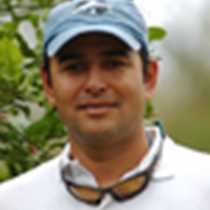Southern Isabela: Urbina Bay & Punta Moreno
Not a lot of people who come to the Galápagos get to visit this beautiful and remote area. Urbina Bay was uplifted by about 12-15 feet in 1954 and shows vast extensions of exposed white coral and rocks with interesting marine encrustations. We found evidence of the deep water crabs, lobsters, sea turtles and other marine organisms that were trapped by this amazing geological event and could not return to their watery element in time.
Once the trail turned inland, the vegetation became quite dense and colorful due to the different angiosperms that are blooming at this time. This has created a great habitat for land iguanas, and indeed we found many of them, some showing bright yellow, as this is the peak of the mating season. We also found a female tortoise taking a nap right in the middle of the trail!
After the hike, we all enjoyed relaxing on the beach, swimming in the surf and riding waves. Six brave and athletic souls swam the 3/4 mile from the beach out to the anchored ship. During lunch we repositioned the National Geographic Islander to Punta Moreno where we had a dry landing and took a mile hike across rough and beautiful lava flows that extended for miles in all directions. We were surprised when we came upon several small and hidden “oasis.” These brackish water lagoons were surrounded by green vegetation such as: Scalesia, poison apple trees, and thorn bushes.
Another option was a longer panga ride in the mangrove system near the landing site. We had to work at getting into the lagoons since the tide was coming down, but it was worth the effort since the whole place was teeming with wildlife; marbled rays, golden rays, heron, pelicans and of course marine turtles.
We are very lucky to have with us this week the sea turtle expert for the Galápagos Islands, Patricia Zarate. This afternoon Patty was extremely excited to see her marine reptiles in these shallow lagoons. She was especially interested in finding a couple individuals of the yellow morpho type of the east pacific green turtle, which has an orange carapace and a yellow plastron. During her research on the nesting beaches to date she has never found a yellow morpho type; it appears that these turtles feed in Galápagos but return to Papa New Guinea where they were hatched to nest. This is an incredibly long migration of about 4000 km across the Pacific Ocean.
As the sun set and we admired a group of over twenty penguins and some immense marine iguanas resting on a lava shelf. It was encouraging to note that most of the penguins were juveniles; they have had a successful breeding season this year! As we motored back to the ship we exalted in the golden light and a perfect end to yet another extraordinary day in the enchanted islands.
Not a lot of people who come to the Galápagos get to visit this beautiful and remote area. Urbina Bay was uplifted by about 12-15 feet in 1954 and shows vast extensions of exposed white coral and rocks with interesting marine encrustations. We found evidence of the deep water crabs, lobsters, sea turtles and other marine organisms that were trapped by this amazing geological event and could not return to their watery element in time.
Once the trail turned inland, the vegetation became quite dense and colorful due to the different angiosperms that are blooming at this time. This has created a great habitat for land iguanas, and indeed we found many of them, some showing bright yellow, as this is the peak of the mating season. We also found a female tortoise taking a nap right in the middle of the trail!
After the hike, we all enjoyed relaxing on the beach, swimming in the surf and riding waves. Six brave and athletic souls swam the 3/4 mile from the beach out to the anchored ship. During lunch we repositioned the National Geographic Islander to Punta Moreno where we had a dry landing and took a mile hike across rough and beautiful lava flows that extended for miles in all directions. We were surprised when we came upon several small and hidden “oasis.” These brackish water lagoons were surrounded by green vegetation such as: Scalesia, poison apple trees, and thorn bushes.
Another option was a longer panga ride in the mangrove system near the landing site. We had to work at getting into the lagoons since the tide was coming down, but it was worth the effort since the whole place was teeming with wildlife; marbled rays, golden rays, heron, pelicans and of course marine turtles.
We are very lucky to have with us this week the sea turtle expert for the Galápagos Islands, Patricia Zarate. This afternoon Patty was extremely excited to see her marine reptiles in these shallow lagoons. She was especially interested in finding a couple individuals of the yellow morpho type of the east pacific green turtle, which has an orange carapace and a yellow plastron. During her research on the nesting beaches to date she has never found a yellow morpho type; it appears that these turtles feed in Galápagos but return to Papa New Guinea where they were hatched to nest. This is an incredibly long migration of about 4000 km across the Pacific Ocean.
As the sun set and we admired a group of over twenty penguins and some immense marine iguanas resting on a lava shelf. It was encouraging to note that most of the penguins were juveniles; they have had a successful breeding season this year! As we motored back to the ship we exalted in the golden light and a perfect end to yet another extraordinary day in the enchanted islands.




